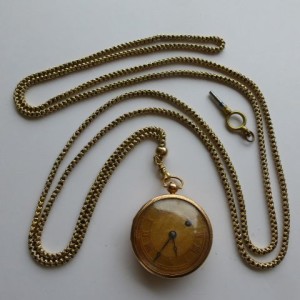 Time again for another fabulous Reg Reader question, this one courtesy of Miss Fairfax whose careful re-reading of Pride and Prejudice noted a previously unnoticed mention of ladies watches.
Time again for another fabulous Reg Reader question, this one courtesy of Miss Fairfax whose careful re-reading of Pride and Prejudice noted a previously unnoticed mention of ladies watches.
Moniker/Name: Miss Fairfax
Your Question: I’ve been rereading ‘Pride & Prejudice’ and came across something that failed to pique my curiosity before: “After walking several miles in a leisurely manner, and too busy to know anything about it, they [Mr. Darcy & Elizabeth] found at last, on examining their watches, that it was time to be at home.”
I can imagine Mr. Darcy’s watch and how he would wear it but I have no idea how Elizabeth’s watch would look and where she would wear it. Was it usual for ladies to wear watches at the time? But then in what fashion? How would they generally look? Thank you!
Source of Question: Research
In La Belle Assemblee 1806, I found the following reference to watches:
I also found in Ackermann’s (1814) a reference to watch chains in an advertisement for various accessories.
In articles on the history of watches, there is some debate about when the first wristwatch was developed. Evidently, the Queen of Naples commissioned a wristwatch from the French watch maker Breguet sometime in 1810 (completed in 1812) (https://www.tourneau.com/catalog/editorial_onecolumn.jsp?pageName=HistoryOfTimeKeepingTimeline).
The Countess Koscowicz of Hungary had a bracelet watch made for her sometime around 1868 (http://www.nytimes.com/2013/10/23/fashion/wrist-watches-from-battlefield-to-fashion-accessory.html). Men, evidently, didn’t start wearing watches on their wrist however until sometime around the turn of the century, when during WWI soldiers jerry-rigged them for easy access (http://www.theatlantic.com/international/archive/2015/05/history-wristwatch-apple-watch/391424/).
Prior to the wristwatch, the portable watch was a pocket watch worn on a chain starting some time n the 1770s (https://www.tourneau.com/catalog/editorial_onecolumn.jsp?pageName=HistoryOfTimeKeepingTimeline). Typically, it would have been kept in a chain (to keep thieves from easy snatching) in a small pocket on the waistcoat (called a fob, which can actually refer to the pocket or the chain). There are some beautiful examples of the decorative yet functional chains and a bit of history on them here: https://thepragmaticcostumer.wordpress.com/2014/04/12/keeping-track-of-time-georgian-watch-chains-equipages-fobs-and-chatelaines/. For some fine examples of watches from the era: http://www.cogsandpieces.com/Antique-Pocket-Watches-1800.html
Pocket watches would have been far less practical for ladies. Often jeweled or made with gold, they would have been valuable enough (and appear from contemporary readings to be a popular object for theft) to probably be kept on the person rather than in a ladies reticule.
The most common reference I could find from Regency era publications was to a ladies watch being worn around the neck. The Lady’s Magazine (1802), for instance, talks of London fashion being:
I have also found some references to pendant watches or watchcases:
Watchcases were decorated with fronts in filigree or painted scenes, similarly to lockets, so that the watch face was concealed:
(The new encyclopedia, 1807).
From all my research, it would appear women’s watches were sometimes worn around the neck, sometimes worn as pins with chains or ribbons allowing them to unclip to be read, sometimes with locket cases, and sometimes without. I imagine some women might have worn them when attire had pockets similar to waistcoats, and maybe more reckless or careless women might have throw them in their reticule. Watches, because they typically were made with gold or other precious materials including jewels, would have been a largely aristocratic accessory, although often were a handsome and practical gift to ladies and men from their betters. Its conceivable that Lizzie’s would have been a gift from a favorite Aunt or Uncle, probably treasured for its gold casing and its utilitarian value, or something inherited and given from her fond papa at a birthday or Christmas.
By 1800, half all watches were made in England, bringing with it an increasing popularity of watches as accessories. A symbol of the rising importance of technology in a rapidly industrializing culture, watches would take the next 100 years to become a commonplace accessory in keeping with the ever increasing importance of time, down to the minute, with inventions of things like railway transportation and factory mechanization.
For more details on English watchmakers, including some business address for watchmakers in the Georgian and Regency era: http://www.british-history.ac.uk/vch/middx/vol2/pp158-165












Oh, thank you very much! This was extremely helpful!